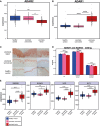Decreased A-to-I RNA editing as a source of keratinocytes' dsRNA in psoriasis
- PMID: 29592874
- PMCID: PMC5959251
- DOI: 10.1261/rna.064659.117
Decreased A-to-I RNA editing as a source of keratinocytes' dsRNA in psoriasis
Abstract
Recognition of dsRNA molecules activates the MDA5-MAVS pathway and plays a critical role in stimulating type-I interferon responses in psoriasis. However, the source of the dsRNA accumulation in psoriatic keratinocytes remains largely unknown. A-to-I RNA editing is a common co- or post-transcriptional modification that diversifies adenosine in dsRNA, and leads to unwinding of dsRNA structures. Thus, impaired RNA editing activity can result in an increased load of endogenous dsRNAs. Here we provide a transcriptome-wide analysis of RNA editing across dozens of psoriasis patients, and we demonstrate a global editing reduction in psoriatic lesions. In addition to the global alteration, we also detect editing changes in functional recoding sites located in the IGFBP7, COPA, and FLNA genes. Accretion of dsRNA activates autoimmune responses, and therefore the results presented here, linking for the first time an autoimmune disease to reduction in global editing level, are relevant to a wide range of autoimmune diseases.
Keywords: A-to-I; RNA editing; interferon; psoriasis.
© 2018 Shallev et al.; Published by Cold Spring Harbor Laboratory Press for the RNA Society.
Figures






Similar articles
-
LL37 complexed to double-stranded RNA induces RIG-I-like receptor signalling and Gasdermin E activation facilitating IL-36γ release from keratinocytes.Cell Death Dis. 2025 Mar 22;16(1):198. doi: 10.1038/s41419-025-07537-9. Cell Death Dis. 2025. PMID: 40121229 Free PMC article.
-
Massive A-to-I RNA editing is common across the Metazoa and correlates with dsRNA abundance.Genome Biol. 2017 Oct 2;18(1):185. doi: 10.1186/s13059-017-1315-y. Genome Biol. 2017. PMID: 28969707 Free PMC article.
-
RNA editing by ADAR1 prevents MDA5 sensing of endogenous dsRNA as nonself.Science. 2015 Sep 4;349(6252):1115-20. doi: 10.1126/science.aac7049. Epub 2015 Jul 23. Science. 2015. PMID: 26275108 Free PMC article.
-
What do editors do? Understanding the physiological functions of A-to-I RNA editing by adenosine deaminase acting on RNAs.Open Biol. 2020 Jul;10(7):200085. doi: 10.1098/rsob.200085. Epub 2020 Jul 1. Open Biol. 2020. PMID: 32603639 Free PMC article. Review.
-
The role of dsRNA A-to-I editing catalyzed by ADAR family enzymes in the pathogeneses.RNA Biol. 2024 Jan;21(1):52-69. doi: 10.1080/15476286.2024.2414156. Epub 2024 Oct 24. RNA Biol. 2024. PMID: 39449182 Free PMC article. Review.
Cited by
-
Transcriptional Landscape of Repetitive Elements in Psoriatic Skin from Large Cohort Studies: Relevance to Psoriasis Pathophysiology.Int J Mol Sci. 2023 Nov 24;24(23):16725. doi: 10.3390/ijms242316725. Int J Mol Sci. 2023. PMID: 38069048 Free PMC article.
-
Genetic Associations Between IL-6 and the Development of Autoimmune Arthritis Are Gender-Specific.Front Immunol. 2021 Sep 3;12:707617. doi: 10.3389/fimmu.2021.707617. eCollection 2021. Front Immunol. 2021. PMID: 34539640 Free PMC article.
-
ADAR1 Editing and its Role in Cancer.Genes (Basel). 2018 Dec 25;10(1):12. doi: 10.3390/genes10010012. Genes (Basel). 2018. PMID: 30585209 Free PMC article. Review.
-
Conservation of A-to-I RNA editing in bowhead whale and pig.PLoS One. 2021 Dec 9;16(12):e0260081. doi: 10.1371/journal.pone.0260081. eCollection 2021. PLoS One. 2021. PMID: 34882682 Free PMC article.
-
Type1 Interferons Potential Initiating Factors Linking Skin Wounds With Psoriasis Pathogenesis.Front Immunol. 2019 Jun 25;10:1440. doi: 10.3389/fimmu.2019.01440. eCollection 2019. Front Immunol. 2019. PMID: 31293591 Free PMC article. Review.
References
-
- Andrews S. 2010. FastQC: A quality control tool for high throughput sequence data. Vol. 2011. http://www.bioinformatics.babraham.ac.uk/projects/fastqc
Publication types
MeSH terms
Substances
Grants and funding
LinkOut - more resources
Full Text Sources
Other Literature Sources
Medical
Miscellaneous
